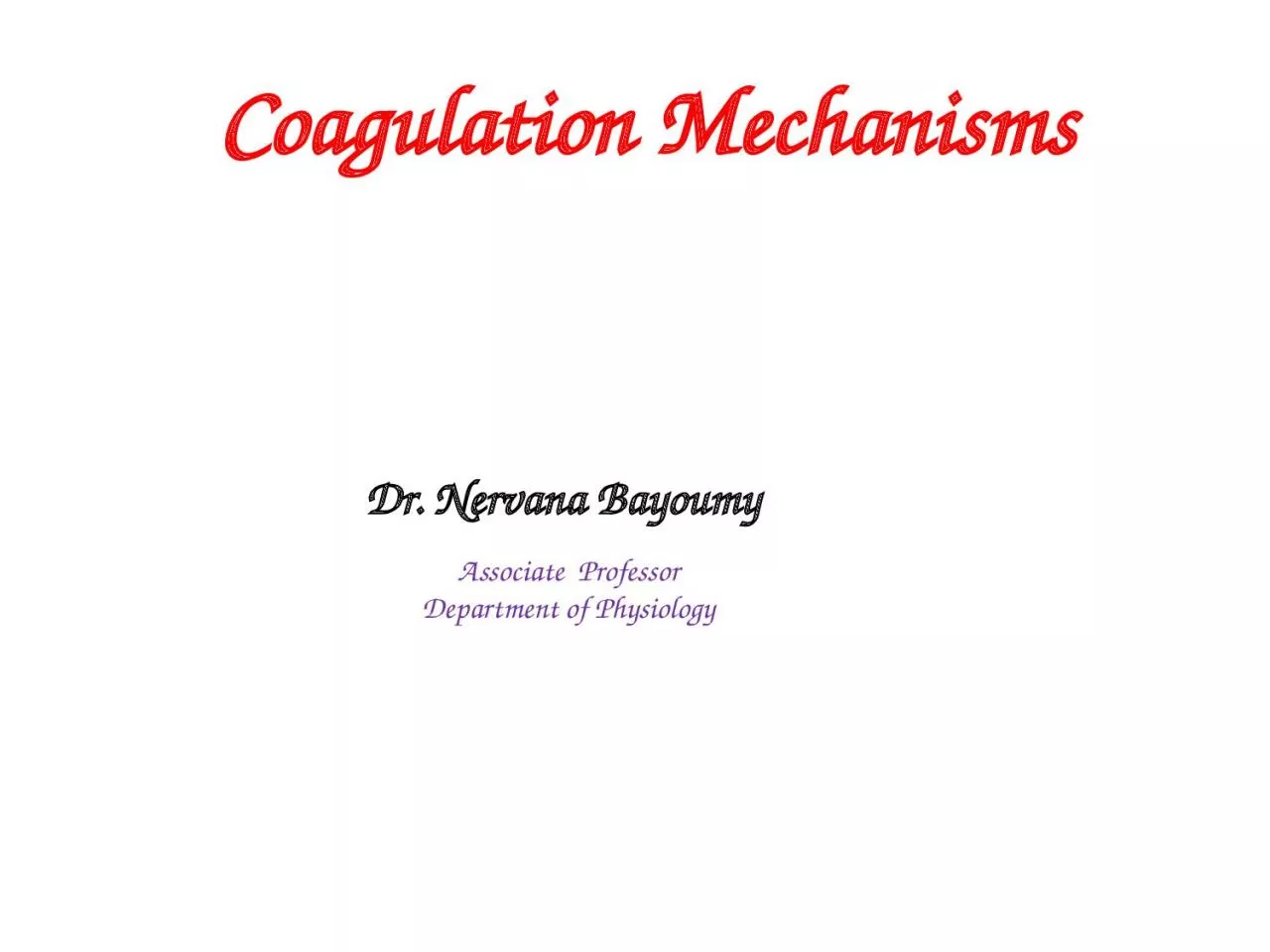

Nervana Bayoumy Associate Professor Department of Physiology Objectives At the end of this lecture you should be able to Recognize the different clotting factors U nderstand the role of calcium ions during clotting cascades ID: 1047503
Download Presentation The PPT/PDF document "Coagulation Mechanisms Dr." is the property of its rightful owner. Permission is granted to download and print the materials on this web site for personal, non-commercial use only, and to display it on your personal computer provided you do not modify the materials and that you retain all copyright notices contained in the materials. By downloading content from our website, you accept the terms of this agreement.
1. Coagulation MechanismsDr. Nervana Bayoumy Associate ProfessorDepartment of Physiology
2. ObjectivesAt the end of this lecture you should be able to:Recognize the different clotting factors Understand the role of calcium ions during clotting cascades.Describe the cascades of intrinsic and extrinsic pathways for clotting.Recognize process of fibrinolysis and function of plasminRecognize some conditions causing excessive bleedingUnderstand some important anticoagulants and their mechanism of action
3. Mechanism of Blood Coagulation• A crucial physiological balance exists between factors promoting coagulation (procoagulants) and factors inhibiting coagulation (anticoagulants). • Coagulation of blood depends on the balance between these two factors.• Disturbances in this balance could lead to thrombosis or bleeding
4.
5. Hemostasis: prevention or stoppage of blood loss. Hemostatic Mechanisms:Vessel wall (Vasoconstriction)Platelets (Production and activation, Platelets Plug formation)Blood coagulation Clot formation (intrinsic & extrinsic pathways) 4. Fibrinolysis
6. Coagulation: Formation of fibrin meshwork (Threads) to form aCLOT
7. Clotting FactorsNamesFactorsFibrinogenProthrombinThromboplastin (tissue factor)CalciumLabile factorStable factorAntihemophilic factorAntihemophilic factor BStuart-Prower factorPlasma thromboplastin antecedent (PTA)Hageman factorFibrin stablizing factorsIIIIIIIVVVIIVIIIIXXXIXIIXIII
8. Prothrombin (factor II): - is a plasma protein, α2-globulin - present in normal plasma in a concentration of 15 mg/dl - it is unstable protein that can be split easily into thrombin - it is continually formed by the liverVitamin K is important for normal production of prothrombin by the liver.Lack of vit K or liver disease can decrease the of prothrombin formation to a very low level >>>> bleedingThrombin: - is a protein enzyme with weak proteolytic capabilities - it acts on fibrinogen to form one molecule of fibrin monomer - fibrin monomers polymerize with one another to form fibrin fibers - it activates factor XIII
9. Fibrin-stabilizing factor (XIII): - is a plasma protein - it is also released from platelets that is entrapped in the clot - it must be activated before it affects the fibrin fibers - activated XIII factor operates as an enzyme causing additional strength of fibrin meshworkFibrinogen (factor I): - is a high-molecular-weight plasma protein - it is continually formed by the liver - little or no fibrinogen leak from blood vesselsBlood Clot: - is composed of a meshwork of fibrin fibers running in all directions and entrapping blood cells, platelets, plasma.
10. Ca++, PL, VIIICa++, PL, VXIIIaCa++XIIIFinalcommonpathwayCa++Extrinsic systemtissue factorVIIaVIIXaX Xthrombin IIaProthrombin IIFibrinFibrin monomerFibrinogen IIntrinsic systemKallik.XIIaHMWKHMWKCa++XIIXIaIXIXaXIPre-K
11. PlateletThrombinVIIIaXIaIXa TFVIIaXaProthrombinFibroblastInitiationAmplificationActivated plateletsXIaIXaXaProthrombinThrombinPropagationCell based model
12. 12ThrombinThrombin changes fibrinogen to fibrinThrombin is essential in platelet morphological changes to form primary plugThrombin stimulates platelets to release ADP & thromboxane A2; both stimulate further platelets aggregationActivates factor V
13. ACTION OF THROMBIN ON FIBRONOGEN TO FORM FIBRIN
14. 14Blood coagulation (clot formation)A series of biochemical reactions leading to the formation of a blood clot within few seconds after injuryProthrombin (inactive thrombin) is activated by a long intrinsic or short extrinsic pathways This reaction leads to the activation of thrombin enzyme from inactive form prothrombinThrombin will change fibrinogen (plasma protein) into fibrin (insoluble protein)
15. 15Intrinsic pathwayThe trigger is the activation of factor XII by contact with foreign surface, injured blood vessel, and glass.Activated factor XII will activate factor XI Activated factor Xl will activate IXActivated factor IX + factor VIII + platelet phospholipid factor (PF3)+ Ca activate factor XFollowing this step the pathway is common for both intrinsic and extrinsic
16. 16Extrinsic pathwayTriggered by material released from damaged tissues (tissue thromboplastin) Tissue thromboplastin + VII + Ca activate XCommon pathwayActivated factor X + factor V +PF3 + Ca activate prothrombin activator; a proteolytic enzyme which activates prothrombin.Activated prothrombin activates thrombinThrombin acts on fibrinogen and change it into insoluble thread like fibrin. Factor XIII + Calcium strong fibrin (strong clot)
17. Activation of Blood CoagulationIntrinsic Pathway: all clotting factors present in the bloodExtrinsic Pathway: triggered by tissue factor (thromboplastin)Common Pathway
18. 18FibrinolysisFormed blood clot can either become fibrous or dissolved.Fibrinolysis (dissolving) = Break down of fibrin by naturally occurring enzyme plasmin therefore prevent intravascular blocking.There is a balance between clotting and fibrinolysisExcess clotting blocking of Blood VesselsExcess fibrinolysis tendency for bleeding
19. FibrinolysisPlasminogenPlasminFibrinogenFibrinFDP*Tissue Plasminogen Activator (t-PA)Anti-plasminAnti-activatorsFDP*: Fibrin Degradation ProductsThrombinReleased from injured tissues and vascular endothelium(Protein in the blood)Fibrinolysis
20. 20PlasminIs present in the blood in an inactive form plasminogenIs activated by tissue plasminogen activators (t-PA) in blood.Digests intra & extra vascular deposit of Fibrin fibrin degradation products (FDP)Unwanted effect of plasmin is the digestion of clotting factors
21. 21PlasminPlasmin is controlled by: Tissue Plasminogen Activator Inhibitor (TPAI)Antiplasmin from the liverUses: Tissue Plasminogen Activator (TPA) used to activate plasminogen to dissolve coronary clots
22. Prevention of blood clotting in the normal vascular system and Anticoagulants Endothelial surface factors Smoothness of the ECS.Glycocalyx layerThrombomodulin proteinFibrin fibers, adsorbs ~ 90% of thrombin to removes it from circulating bloodAntithrombin III, combines the remaining thrombin and removes it from bloodHeparin, combines with Antithrombin III and quickly removes thrombin from blood- Liver, lungs, mast cells, basophils
23. Conditions that cause excessive bleedingVitamin K Deficiency Prothrombin, Factor VII, Factor IX, Factor X require vitamin K for their synthesisHepatitis, Cirrhosis, acute yellow atrophy AND GI diseaseHemophilia↑ bleeding tendency.X-linked disease.Affects males.85% due to Factor VIII deficiency (hemophilia A), and 15% due to Factor IX deficiency (hemophilia B).ThrombocytopeniaVery low number of platelets in blood (< 50,000/μl) Thrombocytopenia purpura, hemorrhages throughout all the body tissues Idiopathic Thrombocytopenia, unknown cause.